Nutrition for Global Health
VerifiedAdded on 2023/06/13
|12
|3781
|244
AI Summary
This article discusses the problem of undernutrition in developing nations, its impact on maternal and child health, and the importance of proper nutrition for physical and mental development. It suggests solutions like government schemes, awareness programs, and CSR activities to eliminate undernutrition and improve human capital. The article also highlights the urgency of spreading awareness about the ill effects of undernutrition and providing basic nutrition to pregnant women.
Contribute Materials
Your contribution can guide someone’s learning journey. Share your
documents today.
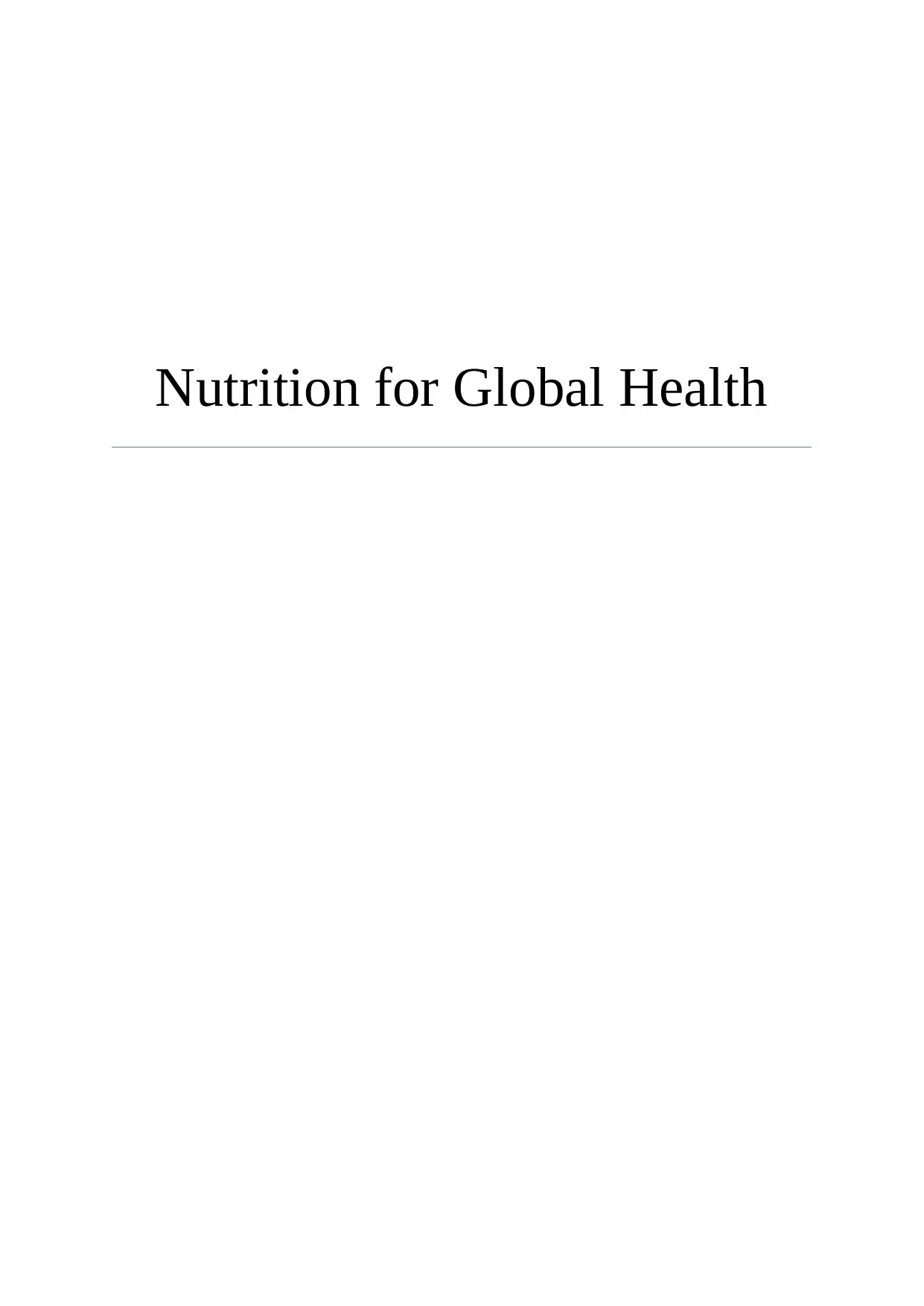
Nutrition for Global Health
Secure Best Marks with AI Grader
Need help grading? Try our AI Grader for instant feedback on your assignments.
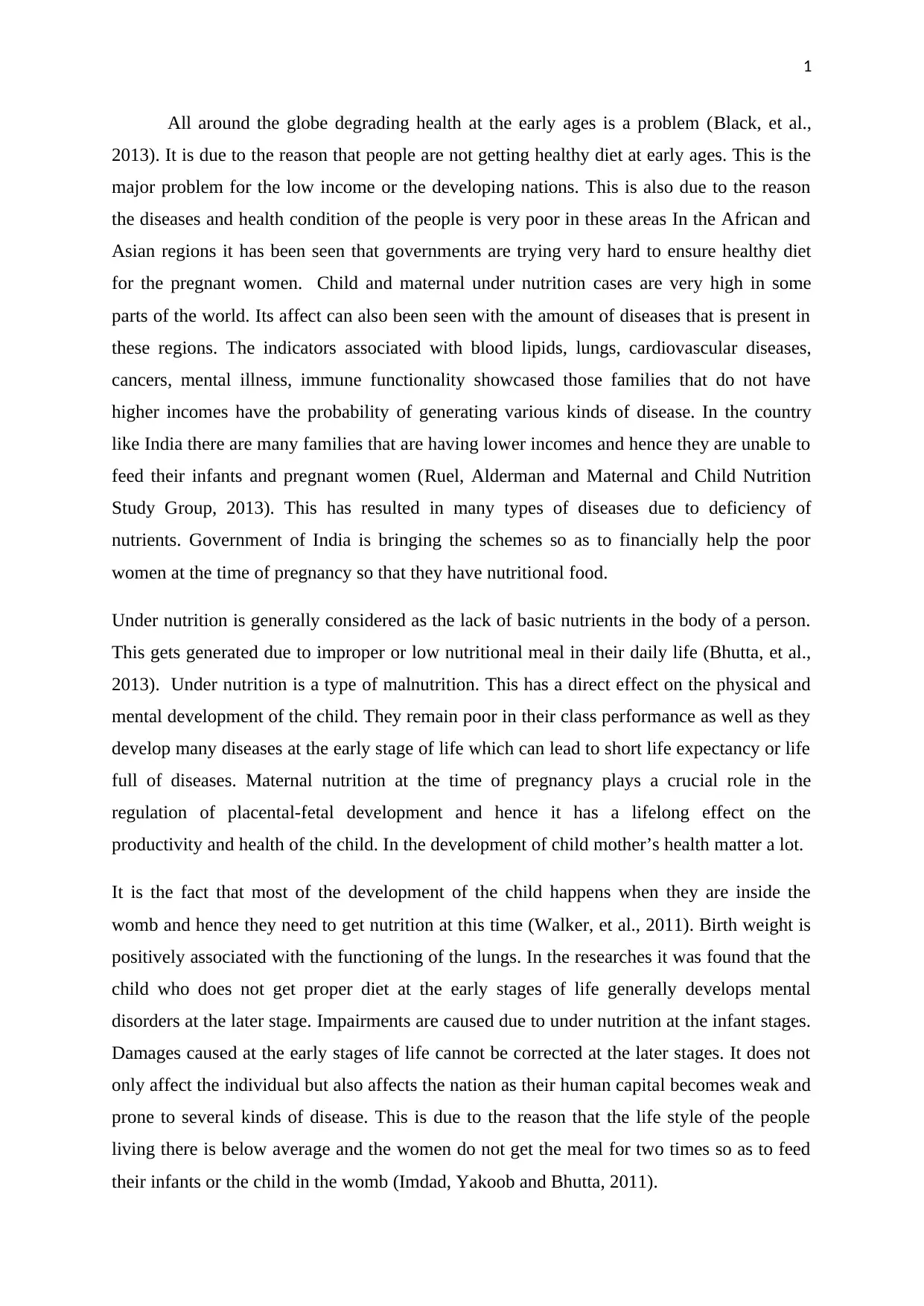
1
All around the globe degrading health at the early ages is a problem (Black, et al.,
2013). It is due to the reason that people are not getting healthy diet at early ages. This is the
major problem for the low income or the developing nations. This is also due to the reason
the diseases and health condition of the people is very poor in these areas In the African and
Asian regions it has been seen that governments are trying very hard to ensure healthy diet
for the pregnant women. Child and maternal under nutrition cases are very high in some
parts of the world. Its affect can also been seen with the amount of diseases that is present in
these regions. The indicators associated with blood lipids, lungs, cardiovascular diseases,
cancers, mental illness, immune functionality showcased those families that do not have
higher incomes have the probability of generating various kinds of disease. In the country
like India there are many families that are having lower incomes and hence they are unable to
feed their infants and pregnant women (Ruel, Alderman and Maternal and Child Nutrition
Study Group, 2013). This has resulted in many types of diseases due to deficiency of
nutrients. Government of India is bringing the schemes so as to financially help the poor
women at the time of pregnancy so that they have nutritional food.
Under nutrition is generally considered as the lack of basic nutrients in the body of a person.
This gets generated due to improper or low nutritional meal in their daily life (Bhutta, et al.,
2013). Under nutrition is a type of malnutrition. This has a direct effect on the physical and
mental development of the child. They remain poor in their class performance as well as they
develop many diseases at the early stage of life which can lead to short life expectancy or life
full of diseases. Maternal nutrition at the time of pregnancy plays a crucial role in the
regulation of placental-fetal development and hence it has a lifelong effect on the
productivity and health of the child. In the development of child mother’s health matter a lot.
It is the fact that most of the development of the child happens when they are inside the
womb and hence they need to get nutrition at this time (Walker, et al., 2011). Birth weight is
positively associated with the functioning of the lungs. In the researches it was found that the
child who does not get proper diet at the early stages of life generally develops mental
disorders at the later stage. Impairments are caused due to under nutrition at the infant stages.
Damages caused at the early stages of life cannot be corrected at the later stages. It does not
only affect the individual but also affects the nation as their human capital becomes weak and
prone to several kinds of disease. This is due to the reason that the life style of the people
living there is below average and the women do not get the meal for two times so as to feed
their infants or the child in the womb (Imdad, Yakoob and Bhutta, 2011).
All around the globe degrading health at the early ages is a problem (Black, et al.,
2013). It is due to the reason that people are not getting healthy diet at early ages. This is the
major problem for the low income or the developing nations. This is also due to the reason
the diseases and health condition of the people is very poor in these areas In the African and
Asian regions it has been seen that governments are trying very hard to ensure healthy diet
for the pregnant women. Child and maternal under nutrition cases are very high in some
parts of the world. Its affect can also been seen with the amount of diseases that is present in
these regions. The indicators associated with blood lipids, lungs, cardiovascular diseases,
cancers, mental illness, immune functionality showcased those families that do not have
higher incomes have the probability of generating various kinds of disease. In the country
like India there are many families that are having lower incomes and hence they are unable to
feed their infants and pregnant women (Ruel, Alderman and Maternal and Child Nutrition
Study Group, 2013). This has resulted in many types of diseases due to deficiency of
nutrients. Government of India is bringing the schemes so as to financially help the poor
women at the time of pregnancy so that they have nutritional food.
Under nutrition is generally considered as the lack of basic nutrients in the body of a person.
This gets generated due to improper or low nutritional meal in their daily life (Bhutta, et al.,
2013). Under nutrition is a type of malnutrition. This has a direct effect on the physical and
mental development of the child. They remain poor in their class performance as well as they
develop many diseases at the early stage of life which can lead to short life expectancy or life
full of diseases. Maternal nutrition at the time of pregnancy plays a crucial role in the
regulation of placental-fetal development and hence it has a lifelong effect on the
productivity and health of the child. In the development of child mother’s health matter a lot.
It is the fact that most of the development of the child happens when they are inside the
womb and hence they need to get nutrition at this time (Walker, et al., 2011). Birth weight is
positively associated with the functioning of the lungs. In the researches it was found that the
child who does not get proper diet at the early stages of life generally develops mental
disorders at the later stage. Impairments are caused due to under nutrition at the infant stages.
Damages caused at the early stages of life cannot be corrected at the later stages. It does not
only affect the individual but also affects the nation as their human capital becomes weak and
prone to several kinds of disease. This is due to the reason that the life style of the people
living there is below average and the women do not get the meal for two times so as to feed
their infants or the child in the womb (Imdad, Yakoob and Bhutta, 2011).
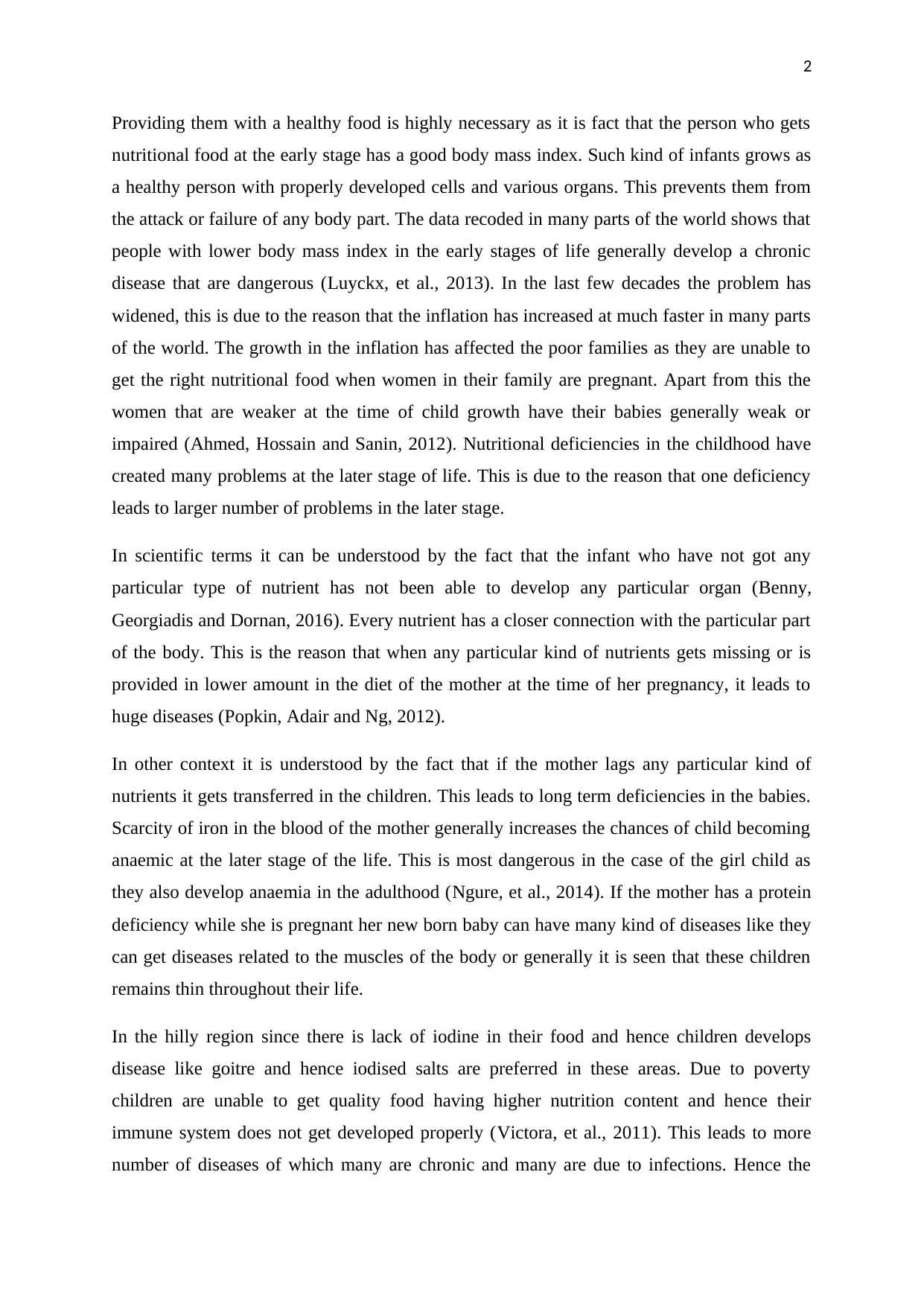
2
Providing them with a healthy food is highly necessary as it is fact that the person who gets
nutritional food at the early stage has a good body mass index. Such kind of infants grows as
a healthy person with properly developed cells and various organs. This prevents them from
the attack or failure of any body part. The data recoded in many parts of the world shows that
people with lower body mass index in the early stages of life generally develop a chronic
disease that are dangerous (Luyckx, et al., 2013). In the last few decades the problem has
widened, this is due to the reason that the inflation has increased at much faster in many parts
of the world. The growth in the inflation has affected the poor families as they are unable to
get the right nutritional food when women in their family are pregnant. Apart from this the
women that are weaker at the time of child growth have their babies generally weak or
impaired (Ahmed, Hossain and Sanin, 2012). Nutritional deficiencies in the childhood have
created many problems at the later stage of life. This is due to the reason that one deficiency
leads to larger number of problems in the later stage.
In scientific terms it can be understood by the fact that the infant who have not got any
particular type of nutrient has not been able to develop any particular organ (Benny,
Georgiadis and Dornan, 2016). Every nutrient has a closer connection with the particular part
of the body. This is the reason that when any particular kind of nutrients gets missing or is
provided in lower amount in the diet of the mother at the time of her pregnancy, it leads to
huge diseases (Popkin, Adair and Ng, 2012).
In other context it is understood by the fact that if the mother lags any particular kind of
nutrients it gets transferred in the children. This leads to long term deficiencies in the babies.
Scarcity of iron in the blood of the mother generally increases the chances of child becoming
anaemic at the later stage of the life. This is most dangerous in the case of the girl child as
they also develop anaemia in the adulthood (Ngure, et al., 2014). If the mother has a protein
deficiency while she is pregnant her new born baby can have many kind of diseases like they
can get diseases related to the muscles of the body or generally it is seen that these children
remains thin throughout their life.
In the hilly region since there is lack of iodine in their food and hence children develops
disease like goitre and hence iodised salts are preferred in these areas. Due to poverty
children are unable to get quality food having higher nutrition content and hence their
immune system does not get developed properly (Victora, et al., 2011). This leads to more
number of diseases of which many are chronic and many are due to infections. Hence the
Providing them with a healthy food is highly necessary as it is fact that the person who gets
nutritional food at the early stage has a good body mass index. Such kind of infants grows as
a healthy person with properly developed cells and various organs. This prevents them from
the attack or failure of any body part. The data recoded in many parts of the world shows that
people with lower body mass index in the early stages of life generally develop a chronic
disease that are dangerous (Luyckx, et al., 2013). In the last few decades the problem has
widened, this is due to the reason that the inflation has increased at much faster in many parts
of the world. The growth in the inflation has affected the poor families as they are unable to
get the right nutritional food when women in their family are pregnant. Apart from this the
women that are weaker at the time of child growth have their babies generally weak or
impaired (Ahmed, Hossain and Sanin, 2012). Nutritional deficiencies in the childhood have
created many problems at the later stage of life. This is due to the reason that one deficiency
leads to larger number of problems in the later stage.
In scientific terms it can be understood by the fact that the infant who have not got any
particular type of nutrient has not been able to develop any particular organ (Benny,
Georgiadis and Dornan, 2016). Every nutrient has a closer connection with the particular part
of the body. This is the reason that when any particular kind of nutrients gets missing or is
provided in lower amount in the diet of the mother at the time of her pregnancy, it leads to
huge diseases (Popkin, Adair and Ng, 2012).
In other context it is understood by the fact that if the mother lags any particular kind of
nutrients it gets transferred in the children. This leads to long term deficiencies in the babies.
Scarcity of iron in the blood of the mother generally increases the chances of child becoming
anaemic at the later stage of the life. This is most dangerous in the case of the girl child as
they also develop anaemia in the adulthood (Ngure, et al., 2014). If the mother has a protein
deficiency while she is pregnant her new born baby can have many kind of diseases like they
can get diseases related to the muscles of the body or generally it is seen that these children
remains thin throughout their life.
In the hilly region since there is lack of iodine in their food and hence children develops
disease like goitre and hence iodised salts are preferred in these areas. Due to poverty
children are unable to get quality food having higher nutrition content and hence their
immune system does not get developed properly (Victora, et al., 2011). This leads to more
number of diseases of which many are chronic and many are due to infections. Hence the
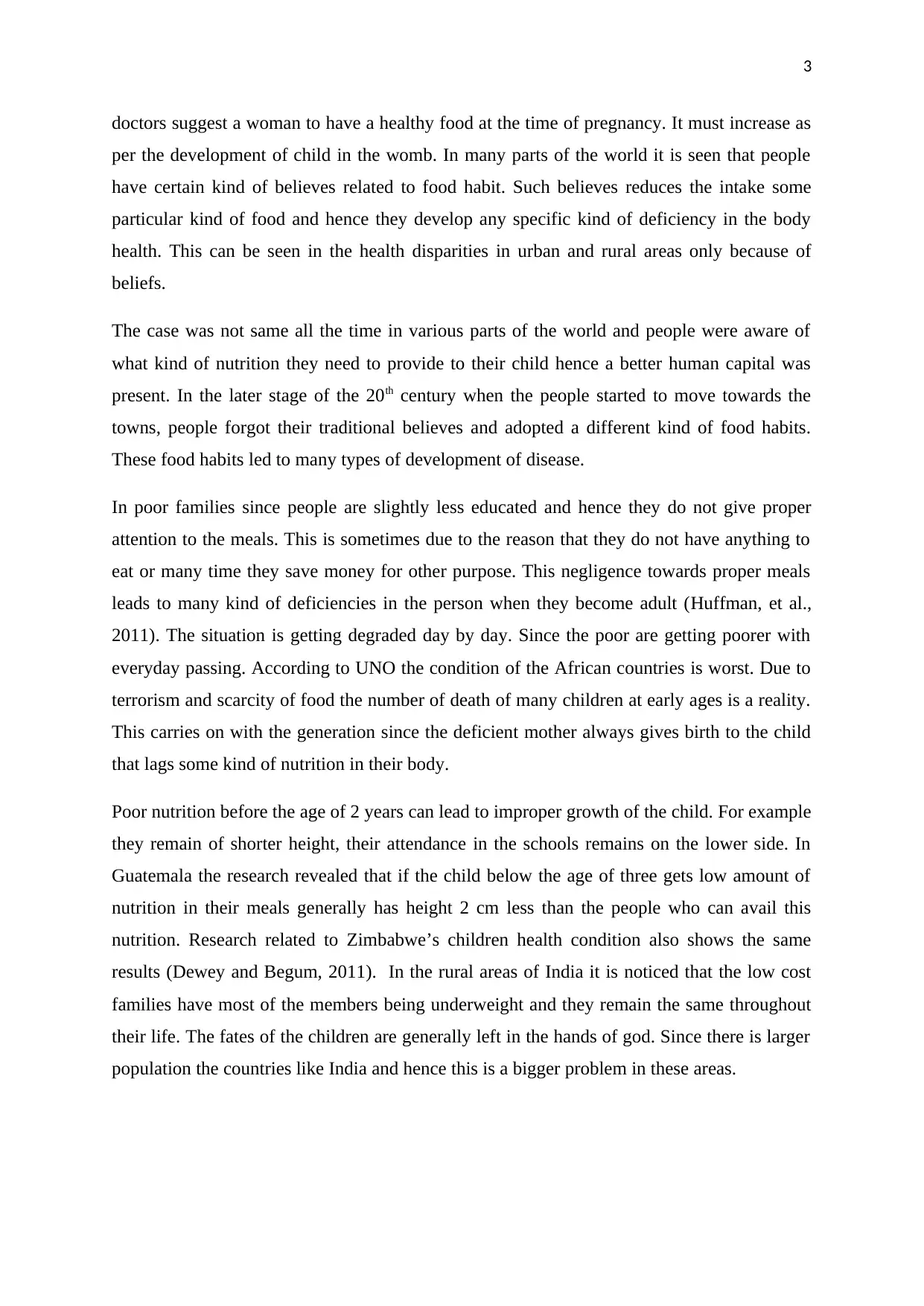
3
doctors suggest a woman to have a healthy food at the time of pregnancy. It must increase as
per the development of child in the womb. In many parts of the world it is seen that people
have certain kind of believes related to food habit. Such believes reduces the intake some
particular kind of food and hence they develop any specific kind of deficiency in the body
health. This can be seen in the health disparities in urban and rural areas only because of
beliefs.
The case was not same all the time in various parts of the world and people were aware of
what kind of nutrition they need to provide to their child hence a better human capital was
present. In the later stage of the 20th century when the people started to move towards the
towns, people forgot their traditional believes and adopted a different kind of food habits.
These food habits led to many types of development of disease.
In poor families since people are slightly less educated and hence they do not give proper
attention to the meals. This is sometimes due to the reason that they do not have anything to
eat or many time they save money for other purpose. This negligence towards proper meals
leads to many kind of deficiencies in the person when they become adult (Huffman, et al.,
2011). The situation is getting degraded day by day. Since the poor are getting poorer with
everyday passing. According to UNO the condition of the African countries is worst. Due to
terrorism and scarcity of food the number of death of many children at early ages is a reality.
This carries on with the generation since the deficient mother always gives birth to the child
that lags some kind of nutrition in their body.
Poor nutrition before the age of 2 years can lead to improper growth of the child. For example
they remain of shorter height, their attendance in the schools remains on the lower side. In
Guatemala the research revealed that if the child below the age of three gets low amount of
nutrition in their meals generally has height 2 cm less than the people who can avail this
nutrition. Research related to Zimbabwe’s children health condition also shows the same
results (Dewey and Begum, 2011). In the rural areas of India it is noticed that the low cost
families have most of the members being underweight and they remain the same throughout
their life. The fates of the children are generally left in the hands of god. Since there is larger
population the countries like India and hence this is a bigger problem in these areas.
doctors suggest a woman to have a healthy food at the time of pregnancy. It must increase as
per the development of child in the womb. In many parts of the world it is seen that people
have certain kind of believes related to food habit. Such believes reduces the intake some
particular kind of food and hence they develop any specific kind of deficiency in the body
health. This can be seen in the health disparities in urban and rural areas only because of
beliefs.
The case was not same all the time in various parts of the world and people were aware of
what kind of nutrition they need to provide to their child hence a better human capital was
present. In the later stage of the 20th century when the people started to move towards the
towns, people forgot their traditional believes and adopted a different kind of food habits.
These food habits led to many types of development of disease.
In poor families since people are slightly less educated and hence they do not give proper
attention to the meals. This is sometimes due to the reason that they do not have anything to
eat or many time they save money for other purpose. This negligence towards proper meals
leads to many kind of deficiencies in the person when they become adult (Huffman, et al.,
2011). The situation is getting degraded day by day. Since the poor are getting poorer with
everyday passing. According to UNO the condition of the African countries is worst. Due to
terrorism and scarcity of food the number of death of many children at early ages is a reality.
This carries on with the generation since the deficient mother always gives birth to the child
that lags some kind of nutrition in their body.
Poor nutrition before the age of 2 years can lead to improper growth of the child. For example
they remain of shorter height, their attendance in the schools remains on the lower side. In
Guatemala the research revealed that if the child below the age of three gets low amount of
nutrition in their meals generally has height 2 cm less than the people who can avail this
nutrition. Research related to Zimbabwe’s children health condition also shows the same
results (Dewey and Begum, 2011). In the rural areas of India it is noticed that the low cost
families have most of the members being underweight and they remain the same throughout
their life. The fates of the children are generally left in the hands of god. Since there is larger
population the countries like India and hence this is a bigger problem in these areas.
Secure Best Marks with AI Grader
Need help grading? Try our AI Grader for instant feedback on your assignments.
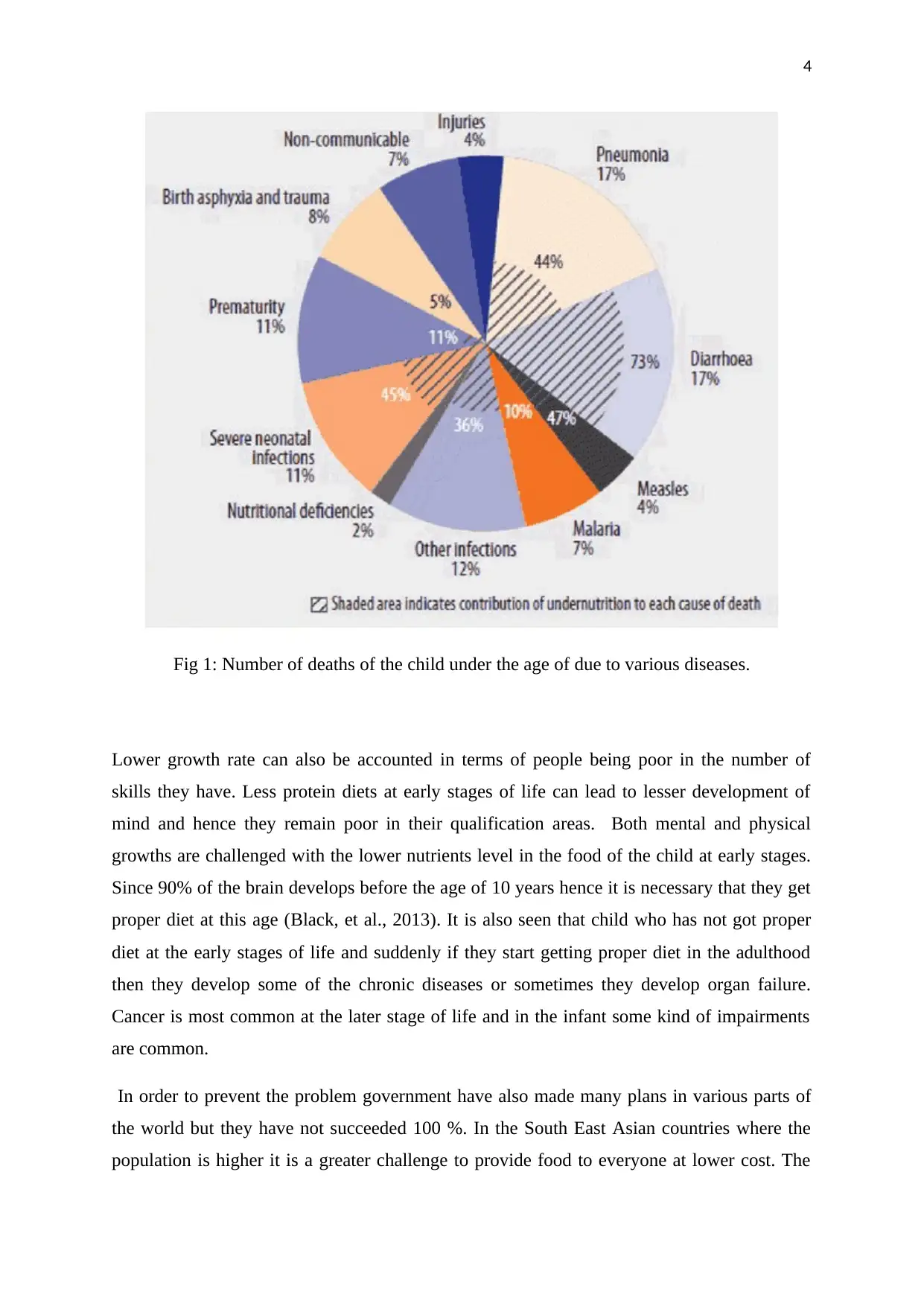
4
Fig 1: Number of deaths of the child under the age of due to various diseases.
Lower growth rate can also be accounted in terms of people being poor in the number of
skills they have. Less protein diets at early stages of life can lead to lesser development of
mind and hence they remain poor in their qualification areas. Both mental and physical
growths are challenged with the lower nutrients level in the food of the child at early stages.
Since 90% of the brain develops before the age of 10 years hence it is necessary that they get
proper diet at this age (Black, et al., 2013). It is also seen that child who has not got proper
diet at the early stages of life and suddenly if they start getting proper diet in the adulthood
then they develop some of the chronic diseases or sometimes they develop organ failure.
Cancer is most common at the later stage of life and in the infant some kind of impairments
are common.
In order to prevent the problem government have also made many plans in various parts of
the world but they have not succeeded 100 %. In the South East Asian countries where the
population is higher it is a greater challenge to provide food to everyone at lower cost. The
Fig 1: Number of deaths of the child under the age of due to various diseases.
Lower growth rate can also be accounted in terms of people being poor in the number of
skills they have. Less protein diets at early stages of life can lead to lesser development of
mind and hence they remain poor in their qualification areas. Both mental and physical
growths are challenged with the lower nutrients level in the food of the child at early stages.
Since 90% of the brain develops before the age of 10 years hence it is necessary that they get
proper diet at this age (Black, et al., 2013). It is also seen that child who has not got proper
diet at the early stages of life and suddenly if they start getting proper diet in the adulthood
then they develop some of the chronic diseases or sometimes they develop organ failure.
Cancer is most common at the later stage of life and in the infant some kind of impairments
are common.
In order to prevent the problem government have also made many plans in various parts of
the world but they have not succeeded 100 %. In the South East Asian countries where the
population is higher it is a greater challenge to provide food to everyone at lower cost. The
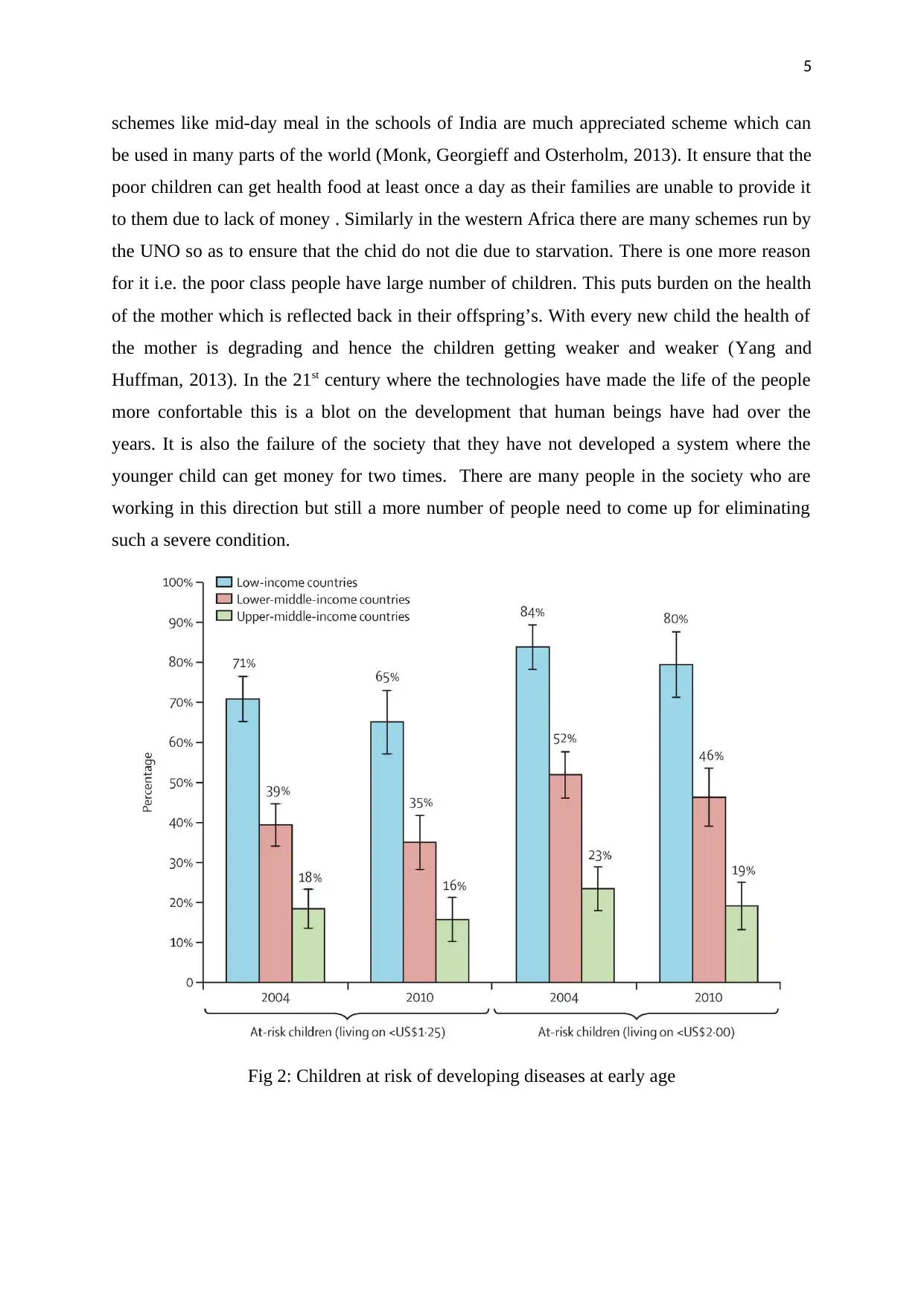
5
schemes like mid-day meal in the schools of India are much appreciated scheme which can
be used in many parts of the world (Monk, Georgieff and Osterholm, 2013). It ensure that the
poor children can get health food at least once a day as their families are unable to provide it
to them due to lack of money . Similarly in the western Africa there are many schemes run by
the UNO so as to ensure that the chid do not die due to starvation. There is one more reason
for it i.e. the poor class people have large number of children. This puts burden on the health
of the mother which is reflected back in their offspring’s. With every new child the health of
the mother is degrading and hence the children getting weaker and weaker (Yang and
Huffman, 2013). In the 21st century where the technologies have made the life of the people
more confortable this is a blot on the development that human beings have had over the
years. It is also the failure of the society that they have not developed a system where the
younger child can get money for two times. There are many people in the society who are
working in this direction but still a more number of people need to come up for eliminating
such a severe condition.
Fig 2: Children at risk of developing diseases at early age
schemes like mid-day meal in the schools of India are much appreciated scheme which can
be used in many parts of the world (Monk, Georgieff and Osterholm, 2013). It ensure that the
poor children can get health food at least once a day as their families are unable to provide it
to them due to lack of money . Similarly in the western Africa there are many schemes run by
the UNO so as to ensure that the chid do not die due to starvation. There is one more reason
for it i.e. the poor class people have large number of children. This puts burden on the health
of the mother which is reflected back in their offspring’s. With every new child the health of
the mother is degrading and hence the children getting weaker and weaker (Yang and
Huffman, 2013). In the 21st century where the technologies have made the life of the people
more confortable this is a blot on the development that human beings have had over the
years. It is also the failure of the society that they have not developed a system where the
younger child can get money for two times. There are many people in the society who are
working in this direction but still a more number of people need to come up for eliminating
such a severe condition.
Fig 2: Children at risk of developing diseases at early age
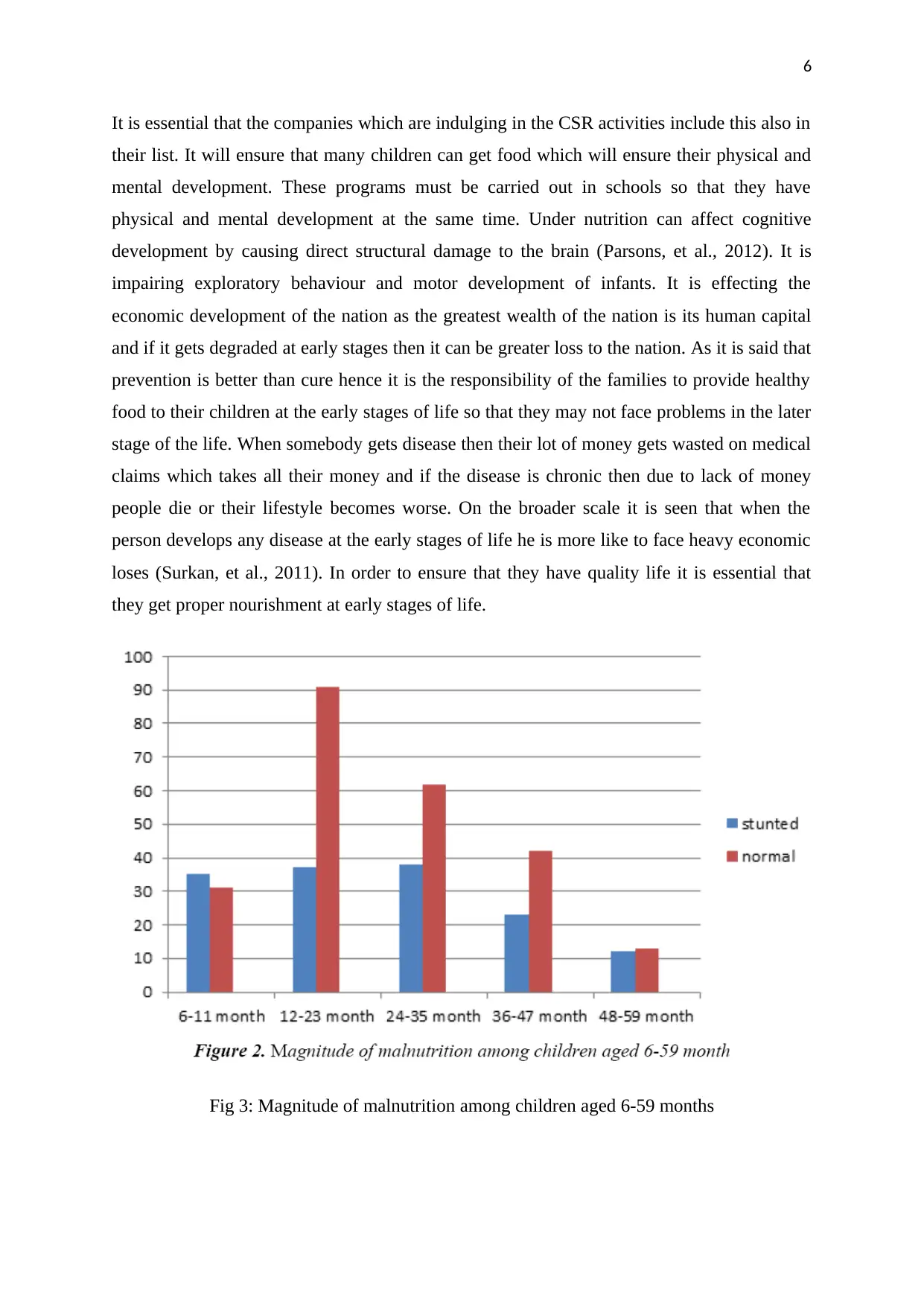
6
It is essential that the companies which are indulging in the CSR activities include this also in
their list. It will ensure that many children can get food which will ensure their physical and
mental development. These programs must be carried out in schools so that they have
physical and mental development at the same time. Under nutrition can affect cognitive
development by causing direct structural damage to the brain (Parsons, et al., 2012). It is
impairing exploratory behaviour and motor development of infants. It is effecting the
economic development of the nation as the greatest wealth of the nation is its human capital
and if it gets degraded at early stages then it can be greater loss to the nation. As it is said that
prevention is better than cure hence it is the responsibility of the families to provide healthy
food to their children at the early stages of life so that they may not face problems in the later
stage of the life. When somebody gets disease then their lot of money gets wasted on medical
claims which takes all their money and if the disease is chronic then due to lack of money
people die or their lifestyle becomes worse. On the broader scale it is seen that when the
person develops any disease at the early stages of life he is more like to face heavy economic
loses (Surkan, et al., 2011). In order to ensure that they have quality life it is essential that
they get proper nourishment at early stages of life.
Fig 3: Magnitude of malnutrition among children aged 6-59 months
It is essential that the companies which are indulging in the CSR activities include this also in
their list. It will ensure that many children can get food which will ensure their physical and
mental development. These programs must be carried out in schools so that they have
physical and mental development at the same time. Under nutrition can affect cognitive
development by causing direct structural damage to the brain (Parsons, et al., 2012). It is
impairing exploratory behaviour and motor development of infants. It is effecting the
economic development of the nation as the greatest wealth of the nation is its human capital
and if it gets degraded at early stages then it can be greater loss to the nation. As it is said that
prevention is better than cure hence it is the responsibility of the families to provide healthy
food to their children at the early stages of life so that they may not face problems in the later
stage of the life. When somebody gets disease then their lot of money gets wasted on medical
claims which takes all their money and if the disease is chronic then due to lack of money
people die or their lifestyle becomes worse. On the broader scale it is seen that when the
person develops any disease at the early stages of life he is more like to face heavy economic
loses (Surkan, et al., 2011). In order to ensure that they have quality life it is essential that
they get proper nourishment at early stages of life.
Fig 3: Magnitude of malnutrition among children aged 6-59 months
Paraphrase This Document
Need a fresh take? Get an instant paraphrase of this document with our AI Paraphraser
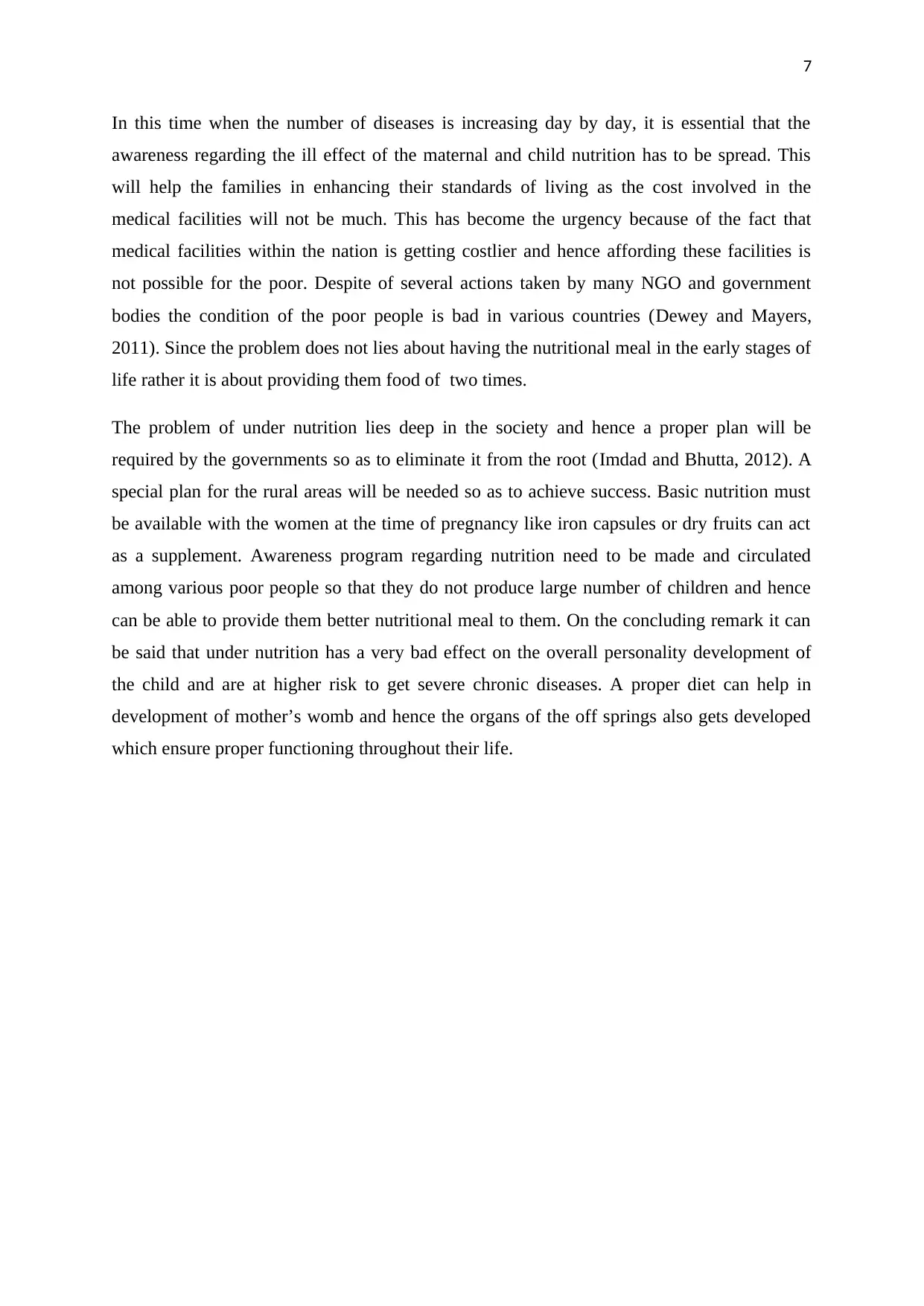
7
In this time when the number of diseases is increasing day by day, it is essential that the
awareness regarding the ill effect of the maternal and child nutrition has to be spread. This
will help the families in enhancing their standards of living as the cost involved in the
medical facilities will not be much. This has become the urgency because of the fact that
medical facilities within the nation is getting costlier and hence affording these facilities is
not possible for the poor. Despite of several actions taken by many NGO and government
bodies the condition of the poor people is bad in various countries (Dewey and Mayers,
2011). Since the problem does not lies about having the nutritional meal in the early stages of
life rather it is about providing them food of two times.
The problem of under nutrition lies deep in the society and hence a proper plan will be
required by the governments so as to eliminate it from the root (Imdad and Bhutta, 2012). A
special plan for the rural areas will be needed so as to achieve success. Basic nutrition must
be available with the women at the time of pregnancy like iron capsules or dry fruits can act
as a supplement. Awareness program regarding nutrition need to be made and circulated
among various poor people so that they do not produce large number of children and hence
can be able to provide them better nutritional meal to them. On the concluding remark it can
be said that under nutrition has a very bad effect on the overall personality development of
the child and are at higher risk to get severe chronic diseases. A proper diet can help in
development of mother’s womb and hence the organs of the off springs also gets developed
which ensure proper functioning throughout their life.
In this time when the number of diseases is increasing day by day, it is essential that the
awareness regarding the ill effect of the maternal and child nutrition has to be spread. This
will help the families in enhancing their standards of living as the cost involved in the
medical facilities will not be much. This has become the urgency because of the fact that
medical facilities within the nation is getting costlier and hence affording these facilities is
not possible for the poor. Despite of several actions taken by many NGO and government
bodies the condition of the poor people is bad in various countries (Dewey and Mayers,
2011). Since the problem does not lies about having the nutritional meal in the early stages of
life rather it is about providing them food of two times.
The problem of under nutrition lies deep in the society and hence a proper plan will be
required by the governments so as to eliminate it from the root (Imdad and Bhutta, 2012). A
special plan for the rural areas will be needed so as to achieve success. Basic nutrition must
be available with the women at the time of pregnancy like iron capsules or dry fruits can act
as a supplement. Awareness program regarding nutrition need to be made and circulated
among various poor people so that they do not produce large number of children and hence
can be able to provide them better nutritional meal to them. On the concluding remark it can
be said that under nutrition has a very bad effect on the overall personality development of
the child and are at higher risk to get severe chronic diseases. A proper diet can help in
development of mother’s womb and hence the organs of the off springs also gets developed
which ensure proper functioning throughout their life.
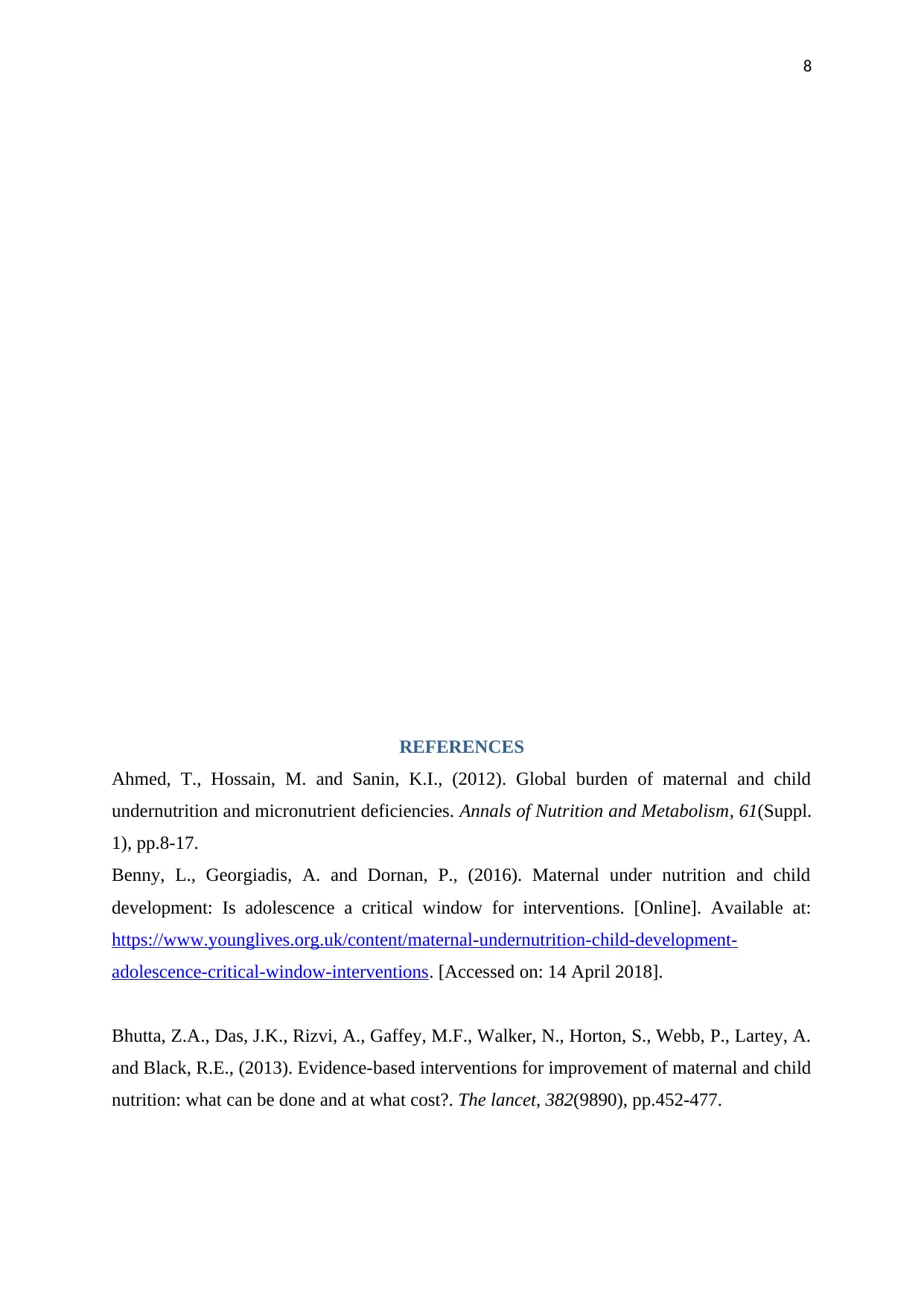
8
REFERENCES
Ahmed, T., Hossain, M. and Sanin, K.I., (2012). Global burden of maternal and child
undernutrition and micronutrient deficiencies. Annals of Nutrition and Metabolism, 61(Suppl.
1), pp.8-17.
Benny, L., Georgiadis, A. and Dornan, P., (2016). Maternal under nutrition and child
development: Is adolescence a critical window for interventions. [Online]. Available at:
https://www.younglives.org.uk/content/maternal-undernutrition-child-development-
adolescence-critical-window-interventions. [Accessed on: 14 April 2018].
Bhutta, Z.A., Das, J.K., Rizvi, A., Gaffey, M.F., Walker, N., Horton, S., Webb, P., Lartey, A.
and Black, R.E., (2013). Evidence-based interventions for improvement of maternal and child
nutrition: what can be done and at what cost?. The lancet, 382(9890), pp.452-477.
REFERENCES
Ahmed, T., Hossain, M. and Sanin, K.I., (2012). Global burden of maternal and child
undernutrition and micronutrient deficiencies. Annals of Nutrition and Metabolism, 61(Suppl.
1), pp.8-17.
Benny, L., Georgiadis, A. and Dornan, P., (2016). Maternal under nutrition and child
development: Is adolescence a critical window for interventions. [Online]. Available at:
https://www.younglives.org.uk/content/maternal-undernutrition-child-development-
adolescence-critical-window-interventions. [Accessed on: 14 April 2018].
Bhutta, Z.A., Das, J.K., Rizvi, A., Gaffey, M.F., Walker, N., Horton, S., Webb, P., Lartey, A.
and Black, R.E., (2013). Evidence-based interventions for improvement of maternal and child
nutrition: what can be done and at what cost?. The lancet, 382(9890), pp.452-477.
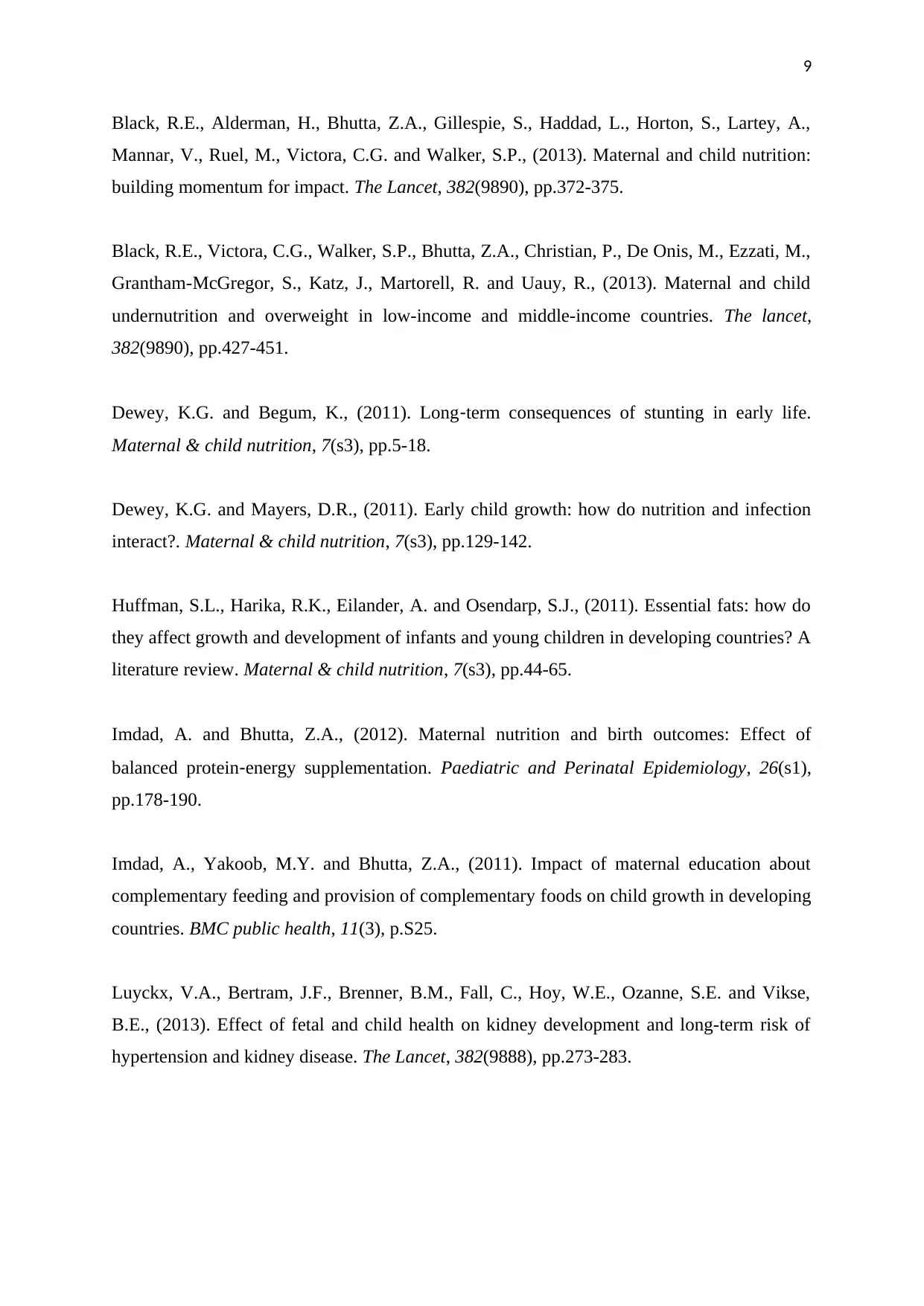
9
Black, R.E., Alderman, H., Bhutta, Z.A., Gillespie, S., Haddad, L., Horton, S., Lartey, A.,
Mannar, V., Ruel, M., Victora, C.G. and Walker, S.P., (2013). Maternal and child nutrition:
building momentum for impact. The Lancet, 382(9890), pp.372-375.
Black, R.E., Victora, C.G., Walker, S.P., Bhutta, Z.A., Christian, P., De Onis, M., Ezzati, M.,
Grantham-McGregor, S., Katz, J., Martorell, R. and Uauy, R., (2013). Maternal and child
undernutrition and overweight in low-income and middle-income countries. The lancet,
382(9890), pp.427-451.
Dewey, K.G. and Begum, K., (2011). Long‐term consequences of stunting in early life.
Maternal & child nutrition, 7(s3), pp.5-18.
Dewey, K.G. and Mayers, D.R., (2011). Early child growth: how do nutrition and infection
interact?. Maternal & child nutrition, 7(s3), pp.129-142.
Huffman, S.L., Harika, R.K., Eilander, A. and Osendarp, S.J., (2011). Essential fats: how do
they affect growth and development of infants and young children in developing countries? A
literature review. Maternal & child nutrition, 7(s3), pp.44-65.
Imdad, A. and Bhutta, Z.A., (2012). Maternal nutrition and birth outcomes: Effect of
balanced protein‐energy supplementation. Paediatric and Perinatal Epidemiology, 26(s1),
pp.178-190.
Imdad, A., Yakoob, M.Y. and Bhutta, Z.A., (2011). Impact of maternal education about
complementary feeding and provision of complementary foods on child growth in developing
countries. BMC public health, 11(3), p.S25.
Luyckx, V.A., Bertram, J.F., Brenner, B.M., Fall, C., Hoy, W.E., Ozanne, S.E. and Vikse,
B.E., (2013). Effect of fetal and child health on kidney development and long-term risk of
hypertension and kidney disease. The Lancet, 382(9888), pp.273-283.
Black, R.E., Alderman, H., Bhutta, Z.A., Gillespie, S., Haddad, L., Horton, S., Lartey, A.,
Mannar, V., Ruel, M., Victora, C.G. and Walker, S.P., (2013). Maternal and child nutrition:
building momentum for impact. The Lancet, 382(9890), pp.372-375.
Black, R.E., Victora, C.G., Walker, S.P., Bhutta, Z.A., Christian, P., De Onis, M., Ezzati, M.,
Grantham-McGregor, S., Katz, J., Martorell, R. and Uauy, R., (2013). Maternal and child
undernutrition and overweight in low-income and middle-income countries. The lancet,
382(9890), pp.427-451.
Dewey, K.G. and Begum, K., (2011). Long‐term consequences of stunting in early life.
Maternal & child nutrition, 7(s3), pp.5-18.
Dewey, K.G. and Mayers, D.R., (2011). Early child growth: how do nutrition and infection
interact?. Maternal & child nutrition, 7(s3), pp.129-142.
Huffman, S.L., Harika, R.K., Eilander, A. and Osendarp, S.J., (2011). Essential fats: how do
they affect growth and development of infants and young children in developing countries? A
literature review. Maternal & child nutrition, 7(s3), pp.44-65.
Imdad, A. and Bhutta, Z.A., (2012). Maternal nutrition and birth outcomes: Effect of
balanced protein‐energy supplementation. Paediatric and Perinatal Epidemiology, 26(s1),
pp.178-190.
Imdad, A., Yakoob, M.Y. and Bhutta, Z.A., (2011). Impact of maternal education about
complementary feeding and provision of complementary foods on child growth in developing
countries. BMC public health, 11(3), p.S25.
Luyckx, V.A., Bertram, J.F., Brenner, B.M., Fall, C., Hoy, W.E., Ozanne, S.E. and Vikse,
B.E., (2013). Effect of fetal and child health on kidney development and long-term risk of
hypertension and kidney disease. The Lancet, 382(9888), pp.273-283.
Secure Best Marks with AI Grader
Need help grading? Try our AI Grader for instant feedback on your assignments.
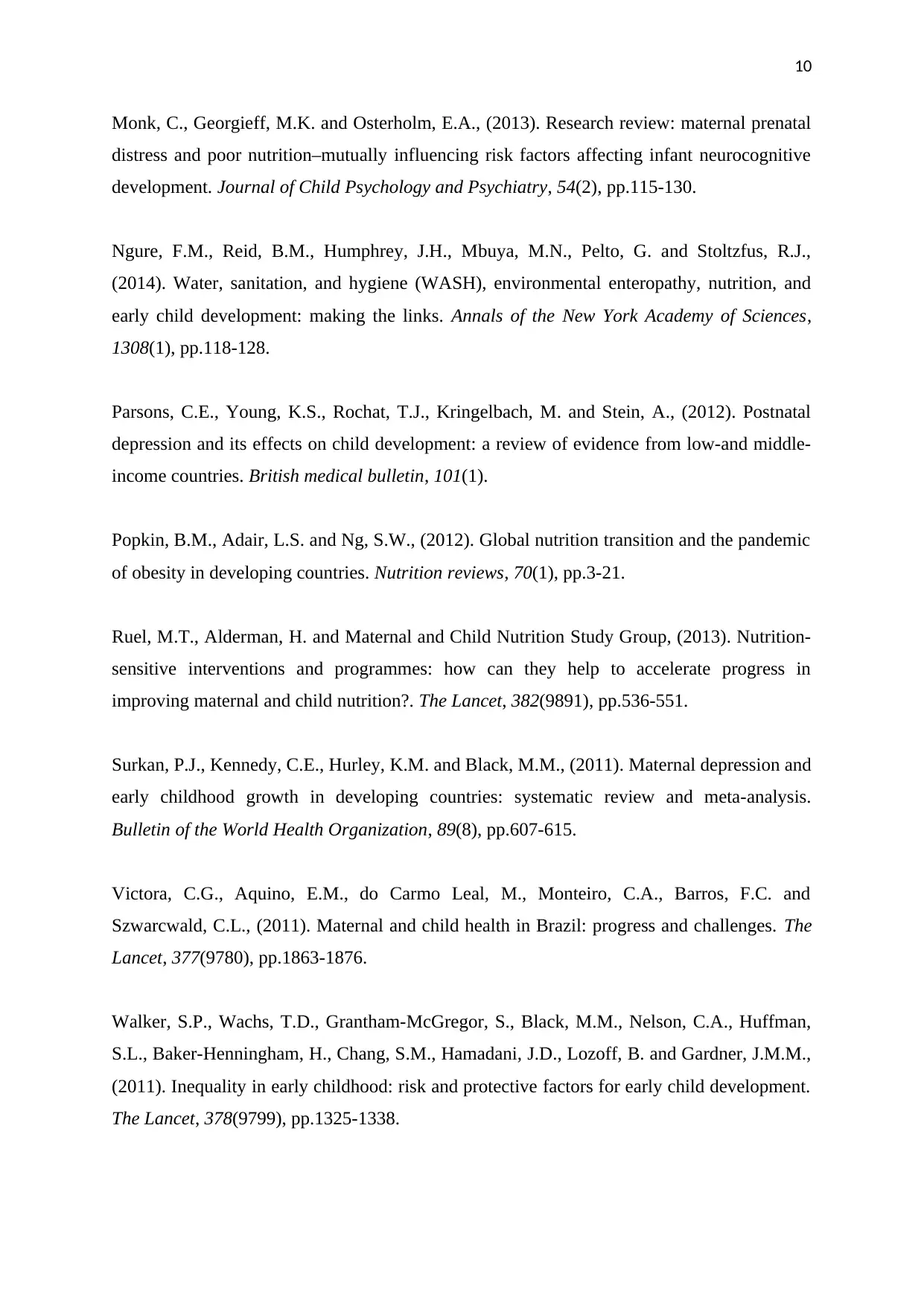
10
Monk, C., Georgieff, M.K. and Osterholm, E.A., (2013). Research review: maternal prenatal
distress and poor nutrition–mutually influencing risk factors affecting infant neurocognitive
development. Journal of Child Psychology and Psychiatry, 54(2), pp.115-130.
Ngure, F.M., Reid, B.M., Humphrey, J.H., Mbuya, M.N., Pelto, G. and Stoltzfus, R.J.,
(2014). Water, sanitation, and hygiene (WASH), environmental enteropathy, nutrition, and
early child development: making the links. Annals of the New York Academy of Sciences,
1308(1), pp.118-128.
Parsons, C.E., Young, K.S., Rochat, T.J., Kringelbach, M. and Stein, A., (2012). Postnatal
depression and its effects on child development: a review of evidence from low-and middle-
income countries. British medical bulletin, 101(1).
Popkin, B.M., Adair, L.S. and Ng, S.W., (2012). Global nutrition transition and the pandemic
of obesity in developing countries. Nutrition reviews, 70(1), pp.3-21.
Ruel, M.T., Alderman, H. and Maternal and Child Nutrition Study Group, (2013). Nutrition-
sensitive interventions and programmes: how can they help to accelerate progress in
improving maternal and child nutrition?. The Lancet, 382(9891), pp.536-551.
Surkan, P.J., Kennedy, C.E., Hurley, K.M. and Black, M.M., (2011). Maternal depression and
early childhood growth in developing countries: systematic review and meta-analysis.
Bulletin of the World Health Organization, 89(8), pp.607-615.
Victora, C.G., Aquino, E.M., do Carmo Leal, M., Monteiro, C.A., Barros, F.C. and
Szwarcwald, C.L., (2011). Maternal and child health in Brazil: progress and challenges. The
Lancet, 377(9780), pp.1863-1876.
Walker, S.P., Wachs, T.D., Grantham-McGregor, S., Black, M.M., Nelson, C.A., Huffman,
S.L., Baker-Henningham, H., Chang, S.M., Hamadani, J.D., Lozoff, B. and Gardner, J.M.M.,
(2011). Inequality in early childhood: risk and protective factors for early child development.
The Lancet, 378(9799), pp.1325-1338.
Monk, C., Georgieff, M.K. and Osterholm, E.A., (2013). Research review: maternal prenatal
distress and poor nutrition–mutually influencing risk factors affecting infant neurocognitive
development. Journal of Child Psychology and Psychiatry, 54(2), pp.115-130.
Ngure, F.M., Reid, B.M., Humphrey, J.H., Mbuya, M.N., Pelto, G. and Stoltzfus, R.J.,
(2014). Water, sanitation, and hygiene (WASH), environmental enteropathy, nutrition, and
early child development: making the links. Annals of the New York Academy of Sciences,
1308(1), pp.118-128.
Parsons, C.E., Young, K.S., Rochat, T.J., Kringelbach, M. and Stein, A., (2012). Postnatal
depression and its effects on child development: a review of evidence from low-and middle-
income countries. British medical bulletin, 101(1).
Popkin, B.M., Adair, L.S. and Ng, S.W., (2012). Global nutrition transition and the pandemic
of obesity in developing countries. Nutrition reviews, 70(1), pp.3-21.
Ruel, M.T., Alderman, H. and Maternal and Child Nutrition Study Group, (2013). Nutrition-
sensitive interventions and programmes: how can they help to accelerate progress in
improving maternal and child nutrition?. The Lancet, 382(9891), pp.536-551.
Surkan, P.J., Kennedy, C.E., Hurley, K.M. and Black, M.M., (2011). Maternal depression and
early childhood growth in developing countries: systematic review and meta-analysis.
Bulletin of the World Health Organization, 89(8), pp.607-615.
Victora, C.G., Aquino, E.M., do Carmo Leal, M., Monteiro, C.A., Barros, F.C. and
Szwarcwald, C.L., (2011). Maternal and child health in Brazil: progress and challenges. The
Lancet, 377(9780), pp.1863-1876.
Walker, S.P., Wachs, T.D., Grantham-McGregor, S., Black, M.M., Nelson, C.A., Huffman,
S.L., Baker-Henningham, H., Chang, S.M., Hamadani, J.D., Lozoff, B. and Gardner, J.M.M.,
(2011). Inequality in early childhood: risk and protective factors for early child development.
The Lancet, 378(9799), pp.1325-1338.

11
Yang, Z. and Huffman, S.L., (2013). Nutrition in pregnancy and early childhood and
associations with obesity in developing countries. Maternal & child nutrition, 9(S1), pp.105-
119.
Yang, Z. and Huffman, S.L., (2013). Nutrition in pregnancy and early childhood and
associations with obesity in developing countries. Maternal & child nutrition, 9(S1), pp.105-
119.
1 out of 12
Related Documents
Your All-in-One AI-Powered Toolkit for Academic Success.
+13062052269
info@desklib.com
Available 24*7 on WhatsApp / Email
![[object Object]](/_next/static/media/star-bottom.7253800d.svg)
Unlock your academic potential
© 2024 | Zucol Services PVT LTD | All rights reserved.





